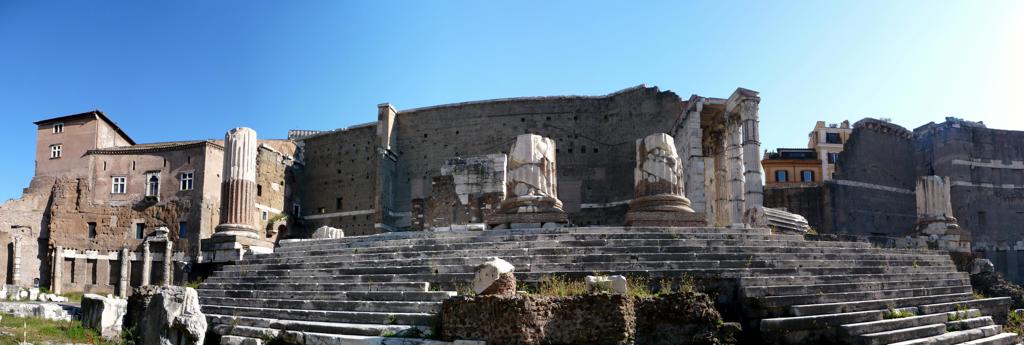About Temple of Mars Ultor
The towering columns of the Temple of Mars Ultor stand as a testament to the grandeur of ancient Rome. These remnants, part of the Forum of Augustus, evoke the power and reverence once commanded by the god of war. The temple, originally constructed in 2 BC, was dedicated to Mars the Avenger, a deity called upon by Augustus to avenge the assassination of Julius Caesar. The remaining Corinthian columns, with their intricate capitals, hint at the temple's former magnificence, where marble and gold once gleamed under the Roman sun.
Augustus commissioned this temple as a fulfillment of a vow made before the Battle of Philippi, where he sought Mars' favor in avenging Caesar's death. The temple not only served religious purposes but also symbolized the might and divine favor of Augustus' rule. It was a place where military standards were stored and where generals departing for war would perform rituals, underscoring the deep connection between Roman religion and military might.
Right Where It Began
The Temple of Mars Ultor marks a pivotal point in Roman history, where Augustus solidified his power and the divine sanction of his leadership. The temple's location in the Forum of Augustus was strategic, aligning with the political and religious heart of Rome. This site was not just a religious center but a political statement, reinforcing Augustus' role as the avenger of Caesar and the restorer of peace and order in Rome. The temple's construction was a monumental task, involving the finest materials and artisans, reflecting the importance of its purpose.
Plan your perfect trip to Rome with Travo! Download now and start exploring.
Marks of Time
The visible ruins of the Temple of Mars Ultor tell stories of time's passage. The surviving columns, though weathered, still stand tall, a testament to Roman engineering and architectural prowess. The temple's foundation and scattered remnants of its once-grand pediment offer a glimpse into the scale and artistry of Roman temple construction. These elements, though fragmented, continue to inspire awe and provide insight into the religious and cultural priorities of ancient Rome.
Stories in Stone
The temple's architecture was rich with symbolism, from the imposing columns to the detailed friezes that once adorned its walls. These friezes depicted scenes of Roman victories and divine interventions, reinforcing the temple's role as a place of both worship and propaganda. The temple's dedication to Mars Ultor was a constant reminder of Augustus' divine mission and the legitimacy of his rule, a narrative carved into the very stones of the structure.
Details That Speak
Close examination of the temple's remains reveals intricate details that speak volumes about Roman artistry and religious devotion. The Corinthian capitals, with their acanthus leaves and volutes, showcase the skill of Roman craftsmen. The temple's orientation and alignment with other structures in the forum highlight the careful planning and symbolic significance embedded in its design. These details, though subtle, contribute to the temple's enduring legacy as a masterpiece of Roman architecture.
Living History
Today, the Temple of Mars Ultor stands as a bridge between past and present, a site where history comes alive for visitors. The temple's ruins are a focal point for understanding the religious and political dynamics of ancient Rome. As part of the larger Forum of Augustus, it continues to draw scholars, tourists, and history enthusiasts, each seeking to connect with the legacy of Rome's imperial past. The temple's presence in modern Rome serves as a reminder of the city's enduring influence and the timeless stories etched into its stones.

Location
Via Tor de' Conti, 00184, Rome



